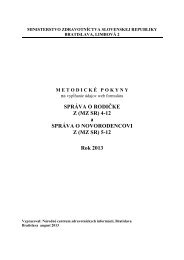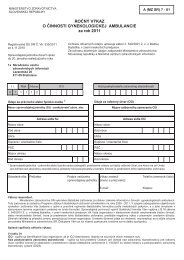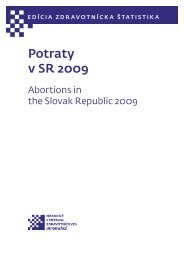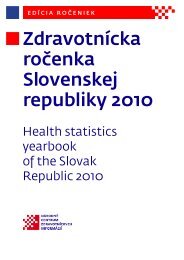ZdravotnÃcka roÄenka
ZdravotnÃcka roÄenka
ZdravotnÃcka roÄenka
You also want an ePaper? Increase the reach of your titles
YUMPU automatically turns print PDFs into web optimized ePapers that Google loves.
1. DemografiaSR 2004V rámci produktívneho veku, ktorý sa celkovo eštezvyšuje (o 12 741 osôb oproti roku 2003), pokračoval užpokles počtu obyvateľov vo vekových skupinách 15 – 24,35 – 39 a 45 – 49-ročných osôb u oboch pohlaví. Ku koncuroka 2004 bolo v produktívnom veku 3 443 735 osôb.Podiel týchto obyvateľov za uvedené obdobie vzrástolo 1.2 bodu a dosiahol takmer 64 % na celkovej populáciiSlovenska.K postupným zmenám dochádza aj vo vekovej štruktúreobyvateľov v poproduktívnom veku. Medziročne vzrástolpodiel obyvateľov v uvedenom veku o 0.3 bodu na 19 %z celkovej populácie. V absolútnom vyjadrení to znamenalozvýšenie počtu o 17 569 na 1 022 172 osôb. Na tomtozvýšení sa ženy podieľali tromi štvrtinami.Zmeny, ktoré prebiehajú vo vekovom zložení obyvateľovSR a ktoré môžeme pozorovať aj na úrovni hlavnýchvekových skupín, označujeme ako populačné starnutie.Prejavuje sa to aj zvyšovaním priemerného veku obyvateľov,ako aj hodnoty ukazovateľov starnutia.Priemerný vek žijúcich obyvateľov sa oproti roku 2003zvýšil u oboch pohlaví a dosiahol u mužov 35.5 a u žien38.7 roka.Vplyvom znižovania podielu detskej zložky a rastompočetnosti osôb v poproduktívnom veku sa ďalej zvýšilindex starnutia o 4.8 bodu na 111.2. To znamená, že na 100obyvateľov vo vekovej skupine 0 – 14-ročných pripadlov roku 2004 už 111.2 osôb v poproduktívnom veku.Rozdielny je index starnutia z pohľadu pohlaví. Zatiaľčo u mužov je na hodnote 72.0, u žien presahuje hodnotu152.0. Je to najmä z dôvodu rozdielnej hranice poproduktívnehoveku u mužov a žien, t. j. z rozdielnej početnostižien vo vyšších vekových kategóriách v dôsledku vyššejúmrtnosti mužov v týchto skupinách.V roku 2004 bolo na Slovensku uzavretých 27 885 manželstiev,čo je o 1 883 viac ako pred rokom. Hrubá mierasobášnosti vzrástla na 5.2 promile. Rast sobášnosti, ktorýtrvá už tretí rok, potvrdzuje predpoklady, že ide o odloženésobáše z minulých rokov.Tendencia dlhodobého vzostupu rozvodovosti na Slovenskus výnimkou v niektorých rokoch pretrváva. Početrozvodov a hrubá miera rozvodovosti sa oproti roku 2003mierne zvýšili. V roku 2004 bolo rozvedených 10 889manželstiev, o 173 viac ako v predchádzajúcom roku.Hrubá miera rozvodovosti vzrástla na 2.02 promile. Znížilsa rozvodový index, najmä v dôsledku vyššieho počtusobášov, keď na 100 uzavretých manželstiev pripadlo 39rozvodov (v roku 2003 to bolo 41.2).Rok 2004 bol z hľadiska reprodukcie obyvateľov významnýtým, že pokračoval obrat vo vývoji pôrodnosti,keď sa medziročne narodilo viac detí a pokračovalo aj znižovaniepotratov a umelých prerušení tehotenstva. V roku2004 sa narodilo 53 958 detí, z toho 53 747 živých. Je todecrease in age groups 15 – 24, 35 – 39 and 45 – 49 wasongoing at both sexes. There was 3 443 735 productivepersons by the end of the year 2004. The share of theseinhabitants was increased by 1.2 points during thereported period and reached almost 64 % of the entirepopulation.Ongoing changes are observed also in the postproductiveage group. The number of inhabitants in this group grewinteranualy by 0.3 point to 19 % of the total. In absolutemeasures it meant an increase of 17 569 to 1 022 172persons. The share of women on this growth was threequaters.Changes running in the age structure of populationobserved on the level of main age groups are indicatedas population ageing. The average age of population isincreased together with the values oh the ageing index.The average age of live inhabitants was increased inboth sexes compared to the year 2003 and reached 35.5years in males and 38.7 years in females.The ageing index was increased by 4.8 points to 111.2under influence of reduced children portion and elevatednumber of persons in postproductive age. It means that100 inhabitants in the age group 0 – 14 corresponds to111.2 persons in postproductive age.The ageing index is different from the aspect of sex.While the males’ value is 72.0 the females exceed thevalue of 152.0. The reason is the different border ofpostproductive age in males and females, i. e. differentnumber of women in higher age groups caused by highermortality of men in these groups.27 885 marriages were contracted in the year 2004,which is by 1 883 more than the year before. The cruderate of marriages has grown to 5.2 ppm. The growthof marriages which lasts for three years confirms theanticipation that we deal with postponed marriages.The trend of long term growth of divorces is kept with anexception of some years. Number of divorces and the crudedivorce rate are slightly increased compared to the lastyear. 10 889 marriages were broken which is by 173 morethan in the year 2003. The crude divorce rate increasedto 2.02 ppm. The divorce index dropped mainly becauseof higher number of marriages closed, 100 marriagescorrespond with 39 divorces(41.2 in 2003).The year 2004 was significant from the reproductionaspect as the natality is continualy growing. The numberof deliveries is increased, and the number of abortionsand arteficial interuptions of pregnancy dropped. 53 958babies were born, out of which 53 747 live born. The cruderate o flive born was increased by 0.4 point to 10.0 ppm.The number of dead born babies was reduced from 4.2 to3.9 recalculated to 1 000 deliveries.

















